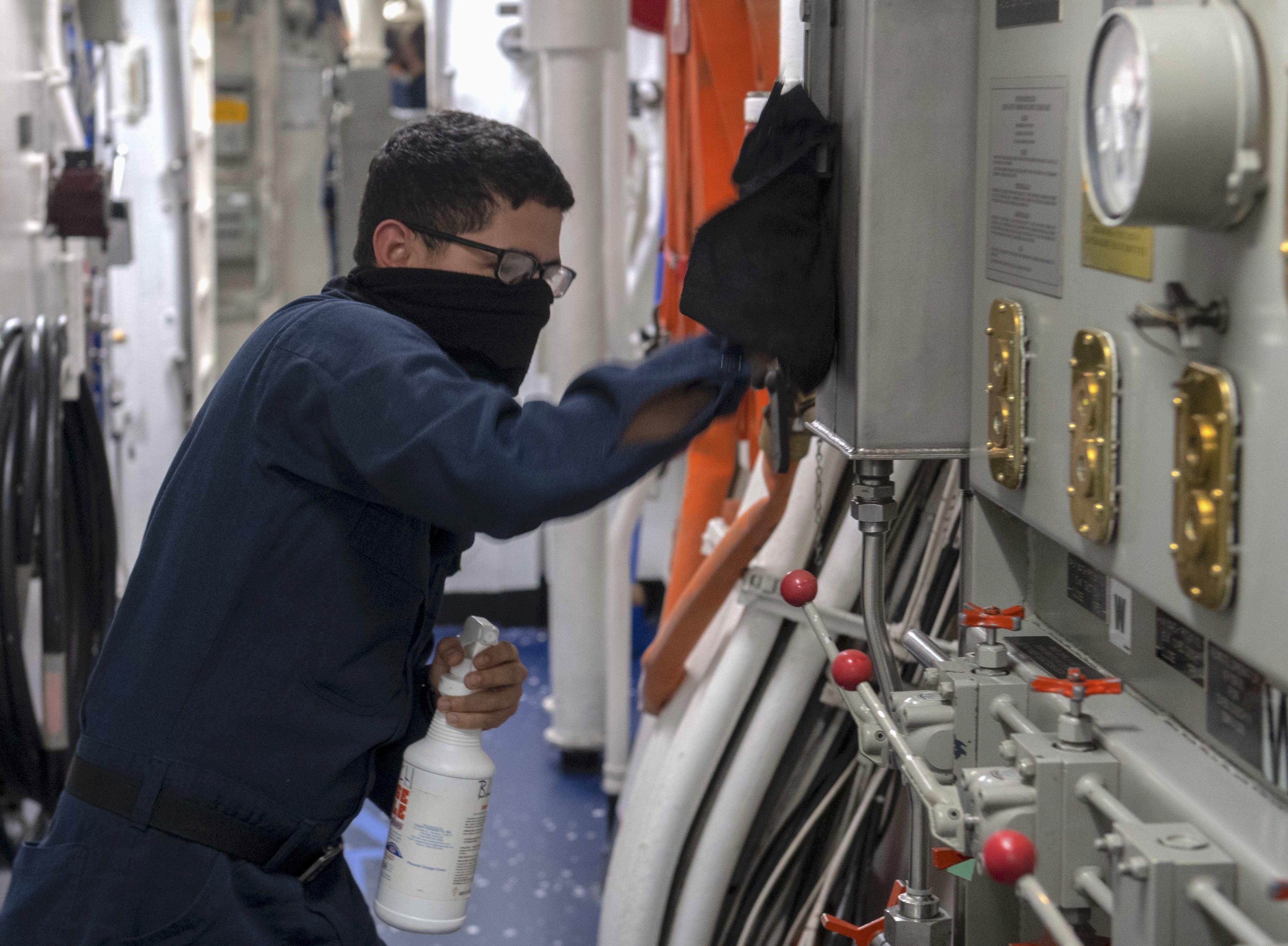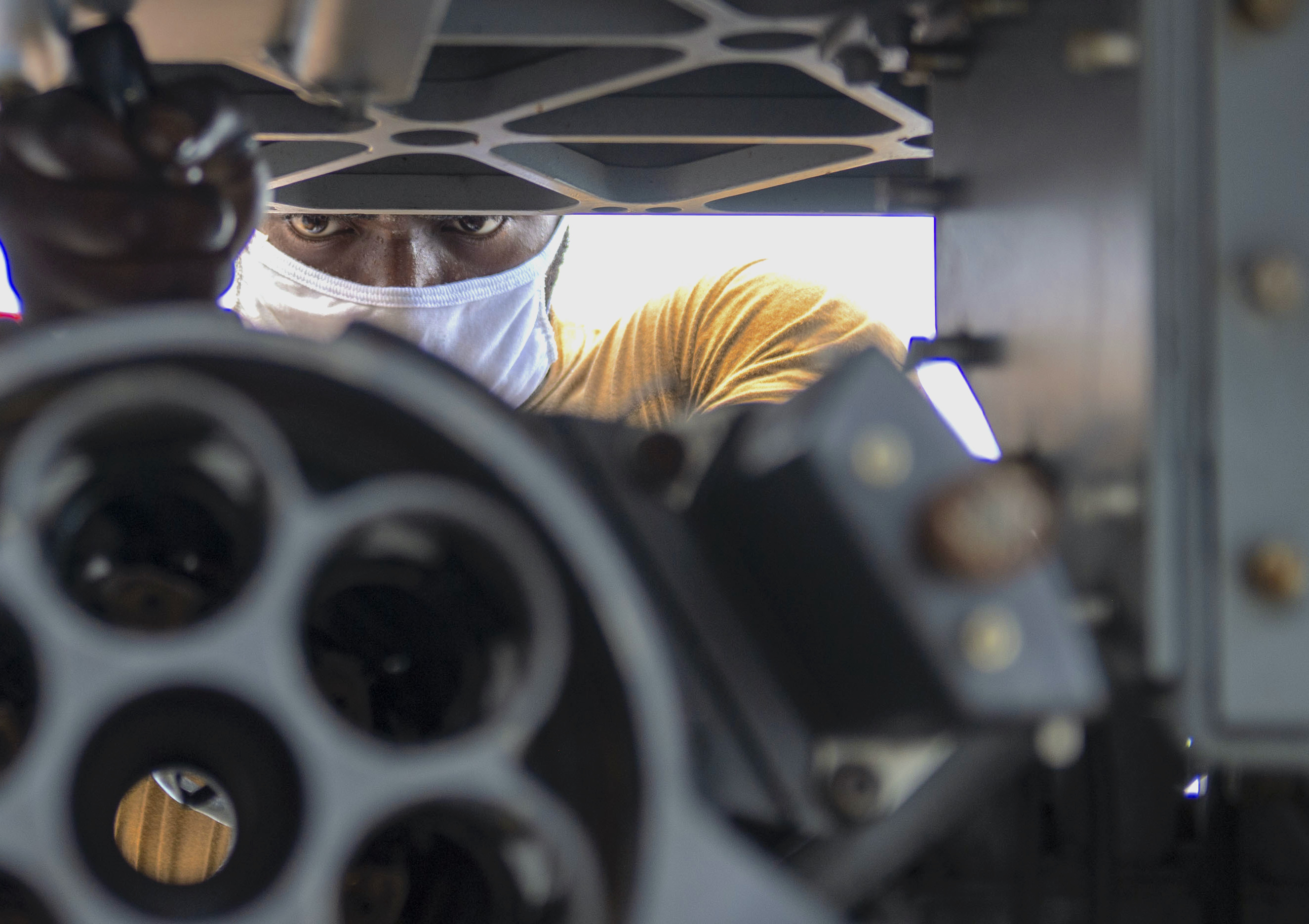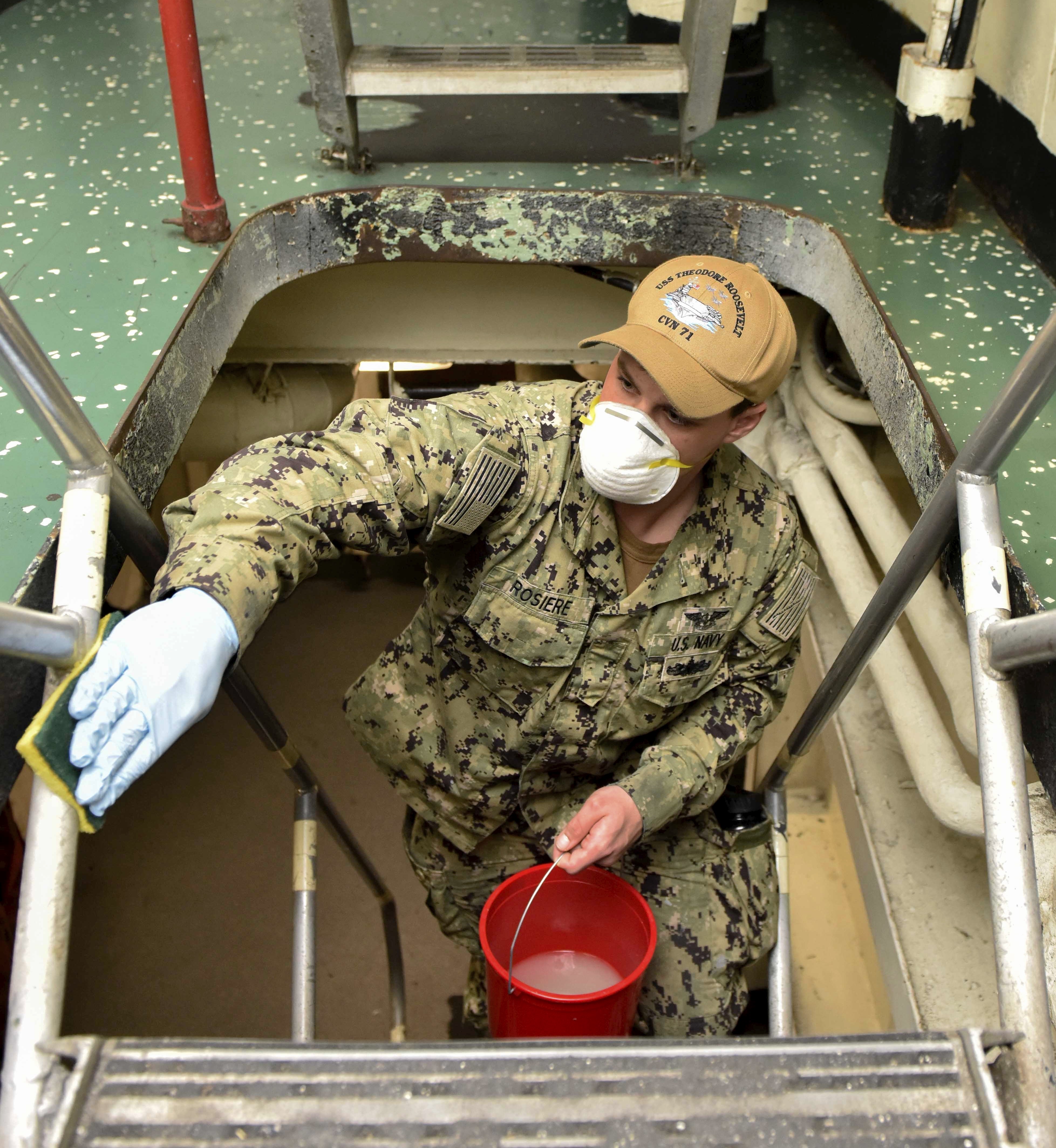
As ship crews find themselves cleaning common spaces much more to prevent the potential spread of COVID-19, the process of sanitizing a large area like the mess deck at the beginning of the pandemic took about three hours. Thanks to a new task group, that’s down to about 30 minutes. And in the future, it could be automated through the use of UV-C light cleaners that can sanitize an entire room.
The Naval COVID Rapid Response Team (NCR2T) at Naval Sea Systems Command (NAVSEA) has taken in more than 100 ideas for potential ways to prevent or eradicate a COVID-19 outbreak on a ship or submarine, and the team continues to triage and research these ideas to push the most promising ones out to the fleet struggling to avoid the virus and be able to remain on station or deploy as planned.
The team has already sent out several iterations of guidance related to which cleaning supplies to use and how to best apply them – addressing both the need to be effective against the SARS-CoV-2 virus as well as the need to be safe for both personnel and equipment aboard – and they continue to work issues including how to use UV-C light to disinfect spaces and how to do better contract tracing if an outbreak does occur.
In early April, after USS Theodore Roosevelt (CVN-71) became the first ship in the U.S. fleet to fight through a COVID-19 outbreak, the chief of naval operations charged NAVSEA with evaluating technologies, developing processes and procedures and providing tools for fleet commanders, type commanders and ship commanders to ensure and promote mission readiness amid this global pandemic.
“NAVSEA is the scientific and engineering expert for the fleet, and so even though this wasn’t typically in our quote, unquote, mission, if you look at our mission – to provide the fleet with the scientific and engineering excellence to come up with solutions – this really does kind of fit,” Rear Adm. Jason Lloyd, the Navy’s chief engineer and NAVSEA’s deputy commander for ship design, integration and naval engineering (SEA 05), told USNI News in a phone interview.
The only difference, he said, is “we’re developing solutions for a totally different fight right now than we normally develop solutions for.”
Doug Arnold, NAVSEA’s director of marine engineering and the NCR2T lead, used the cleaning products effort as an example of how the team was able to move much faster than scientists and engineers would typically prefer.
Starting with hundreds of potential cleaners – far too many to test out in a lab setting for efficacy against COVID-19 and for safety of the sailors and the combat system consoles, touchscreen navigational tools, and machinery they use in their daily jobs – Arnold said the team first looked at what third-party testing had already been done and what scientific articles and data were available. They then grouped the cleaners into categories to try to eliminate entire categories of cleaners that might not be suitable. Alcohol-based cleaners are great for small areas, Arnold offered as an example, but are toxic when used in large areas, so those were nixed early on.
Working closely with the Centers for Disease Control and Prevention (CDC) and the Navy Bureau of Medicine and Surgery (BUMED), the group settled on quaternary ammonium chloride salt cleaners – a category that was then whittled down further based on what substances they’d have to be mixed with and if those were safe to use on Navy shipboard systems, as well as the availability of the cleaner and any additives. After getting rid of the chaff and focusing on the best ideas, Arnold said, the team could test out just a couple of solutions and make sure they sent the fleet a safe and effective idea with instructions for mixing and applying that were feasible in a deployed ship environment.

Arnold said the work isn’t over yet, as they take in fleet feedback and continue to refine some of the ideas. Whereas the process for cleaning a large area such as a mess deck originally took about three hours, the NAVSEA team was able to come up with a new process that takes just 30 minutes now – meaning a ship’s mess deck could actually be cleaned after every single meal is served, greatly limiting the spread of the virus if it were to be brought aboard.
Lloyd said that, with a near-term solution achieved on the cleaners front, the next two most important initiatives deal with UV-C lights and contact tracing.
“For instance, if you could find a large room on a ship that had been contaminated and you could go put this UV-C light in that room to kill the COVID virus overnight, then that’s a lot less taxing on the sailors than having to go clean all the individual surfaces and spaces. So UV-C technology is one of the big ones they’re working on now,” Lloyd said, noting the team was about a month and a half into its research on this topic area.
Lloyd and Arnold said it was up to the fleet to reprioritize money in their budgets to pay for these solutions, but they said it was a pretty easy sell given that it buys the fleets operational readiness. As for the research, they said the warfare centers, labs and other teams were funded to work on high-priority issues for the Navy, and so this COVID-19 research was just displacing other lower-priority work for the time being and wasn’t an extra bill for them.
“We’ll stay around as long as it’s needed to keep fighting this disease, as long as we’re making more progress – which, like I said, we still are,” Lloyd said.
“So we’ll keep doing what we need to do to support the Navy and the nation as long as they need us to.”
Elsewhere in the Navy, best practices that rely more on common sense than engineering are also being shared, Vice Adm. Richard Brown, the commander of Naval Surface Forces and Naval Surface Force Pacific, told USNI News last month.
“The things you should do in your galley, like there’s no self-serve anymore. There are no community-use condiments like the ketchup bottle. You get individual ketchup packages. It’s all these little micro things you need to think about that you can provide guidance for in a general format that each individual commander can then apply,” he said.
Nothing is fool-proof, though. Destroyer USS Kidd (DDG-100) came down with a COVID-19 outbreak in its crew about a month after its last port visit, leaving leaders unsure how the virus got aboard, how it remained undetected for so long and how to tackle a virus that leaves many of its victims asymptomatic.

“When the Kidd got underway from Hawaii, they got our first email and they started the cleaning and the disinfecting and the social distancing as much as you can do on a destroyer. They stopped serving self-serve on the mess decks, they closed down their gyms and the classrooms,” Brown said.
USNI News last reported that 78 sailors on Kidd and more than 1,000 on Theodore Roosevelt had become sick with COVID-19.
The Naval COVID Rapid Response Team has about 35 to 40 personnel dedicated to the effort – in addition to their regular day jobs– and it also works closely with the Office of Naval Research, Navy labs and warfare centers, industry, government agencies like the Department of Homeland Security and the National Institutes of Health, and industry. Arnold said that six subgroups are working in tandem to quickly get solutions out to the fleet:
- A New Ideas and International Best Practices group is the first stop for incoming ideas. They triage ideas based on what initially seems effective against the virus and practical for a deployed ship, and then help sort them into near-, mid- and long-term initiatives. They have also met with nearly 40 other countries’ navies to understand what best practices and solutions they’ve found and to share U.S. Navy research findings in return.
- The Validation and Test team conducts literature reviews and then conducts any lab research needed to fill in the gaps. They also make sure solutions could be employed by the average sailor, because “if it has to be employed by someone with a PhD or a scientist in a lab setting, that’s not really practical for onboard ships,” Arnold said.
- The Interface team works with other government agencies as well as industry associations to share problems they’ve encountered and best practices they’ve implemented.
- The Logistics team ensures that any tools being sent to the fleet include proper instructions, stock numbers for resupply and other requirements to sustain their operations.
- The Shore Support team looks at processes for bringing goods and people from the shore to a deployed ship without contaminating an otherwise clean bubble the ship has created by being at sea without any outside contact with potential sources of contamination.
- The Deployment team focuses on writing procedures and fleet advisories that are simple to follow in a deployed environment, as well as taking feedback from sailors who have implemented these procedures and have ideas for how to make them easier to execute or questions about how to adapt them to their particular situation.
Ideas can be sent to defeatCOVIDideas.fct@navy.mil.





